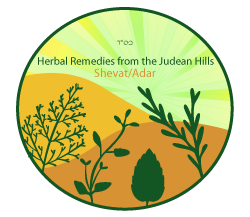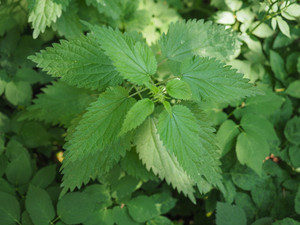Herbal Remedies from the Judean Hills
סִּרְפָּד – Stinging Nettle – Urtica Dioica
Printable Version
Benefitting from Burning Nettle
My strongest memory of stinging nettle, with its deeply toothed, dark green leaves, is as a child in the Danish forest. While picking wild raspberries or just hiking, I would often be attacked by these aggressive stinging plants that caused little, white itching blisters. You can understand why I don’t really mind not having stinging nettle in my garden today. Nettles prefer rich, moist, soil and especially favor the edge of streams or nutrient-dense pastures. No wonder, I haven’t seen much of them in the dry area of southern Israel where we live.
They grow in the lush, moist pastures of northern Israel and even in my friend’s greener garden here in Bat Ayin. All over cold rainy Europe and America, nettle grows in wastelands, woodlands and by the roadside. I have no experience harvesting nettle but I have learned that if you grasp a nettle firmly, it won’t sting– it is the light touch that causes the itching discomfort of a nettle sting. Nettle’s Latin name comes from the word ‘uro,’ meaning ‘I burn.’ Interestingly, this word is similar to the use of the Hebrew word אוּר/Uhr as in אוּר כָּשְׁדִים/Uhr Kashdim – ‘the fires of the Chaldeans,’ which Avraham survived. The Danish name ‘brændenælde’ literally means ‘burning nettle,’ an appropriate name, considering the burning discomfort induced by thethe nettle-sting. Some think that the common name for the nettle comes from the Anglo Saxon word ‘noedl,’ or needle, possibly referring to the tiny hairs that pierce the skin and inject the acid that causes a nettle sting. It could also refer to the plant’s long use in making fabric. The Hebrew name סִּרְפָּד/sirpad is also related to burning, as the root ש-ר-ף/sin-reish-peh means ‘burn,’ the letter ס/samech being interchangeable with ש/sin since they both share the ‘s’ sound. In spite of the temporary burning discomfort, stinging nettle is actually a valuable perennial, with a wealth of health benefits. I have personally used it as a tea to alleviate hay fever, for which nettle is most popular. Throughout history, nettle has been used for treating painful muscles and joints, eczema, arthritis, gout, and anemia. Today, it is used primarily to treat urinary symptoms, eczema, allergies and joint pain.
The Burning Nettle Transforming into a Sweet Smelling Myrtle
Although in English Bible translations, you may find the word nettle several times, for example in Ezekiel 2:6, Hosea 9:6 and Zephaniah 2:9, the Hebrew word סִּרְפָּד/sirpad only appears once:
תַּחַת הַנַּעֲצוּץ יַעֲלֶה בְרוֹשׁ, תַחַת {וְתַחַת} הַסִּרְפָּד יַעֲלֶה הֲדַס וְהָיָה לַהָשֵׁם לְשֵׁם לְאוֹת עוֹלָם לֹא יִכָּרֵת:
(ספר ישעיה פרק נה פסוק יג)
“Instead of the thorn shall the Cypress come up, and instead of the nettle shall the myrtle rise; and it shall be to Hashem for a name, for an everlasting sign that shall not be cut off
(Yesha’yahu 55:13).
Most commentaries on this Torah verse describe the nettle as an annoying thorn that grows in the dessert (Radak, Abarbanel, Torat Moshe). Therefore, it is hard to believe that סִּרְפָּד/sirpad refers to the stinging nettle, which requires moist, nitrogen-rich soil. Our prophetic verse refers to the ‘nettle’ as an allegory for the wicked who will perish while the righteous will take their place. Whereas the myrtle is a symbol for good, the ‘sirpad’ is described as an incarnation of ‘evil.’ According to Metzudat David, the latter refers to the nations, whereas the former refers to Israel, who will ultimately rule in their place. The Talmud explains, “instead of the nettle”– Instead of Vashti, the wicked, the daughter of the son of Nebuchadnezer, the wicked, who burned the house of Hashem… “shall the myrtle come up” – This is Esther, the righteous who was called Hadassah… (Babylonian Talmud, Megilah 10b). There are several parallels between Vashti and the stinging nettle. The fact that Vashti is the granddaughter of the evil Nebuchadnezer, who burned our holy Temple, is certainly congruent with the burning associations of the stinging nettle. The word סִּרְפָּד/sirpadis also related to רְפִידָתוֹ זָהָב/refidato zahav – “its couch of gold” (Song of Songs 3:10), a reference to the Temple that Vashti vehemently opposed rebuilding (Midrash Esther Rabbah 5:2). Interestingly, the letters of סִּרְפָּד/sirpad include the letters of הֲדַס/hadas – ‘myrtle,’ while the remaining letters פ-ר/peh-reishrefers to the 280 harsh judgments. These judgements need to be sweetened in order that the סִּרְפָּד/sirpad can be transformed to הֲדַס/hadas, which has the numerical value of חֶסֶד/chesed– when adding the three letters of its word (Parparaot l’Chachma, Likutim).
We can also understand myrtle, taking the place of the nettle, as a metaphor for the kind of Torah that is acceptable to Hashem. The myrtle exudes a pleasant aroma (is acceptable) on condition that our Torah is integrated with its four levels, which are alluded to in the word סִּרְפָּד/sirpad – sod (secret/kabbalah), remez (allusion/numerology etc.), peshat(simple meaning) and drush (homiletic level) (Imrei Noam, Shut 3).
Spiritual Transformative and Assertive Inner Warrior Plant
Nettle teaches us to transform painful life experiences into personal growth, just as the stinging nettle itself produces a beneficial tonic. Although nettle is an energetically sharp, spiky plant, if we take the time to approach it properly we find it full of wisdom and goodness. Nettle may protect the inner selves of those who are easily overwhelmed, to help them define structure and boundaries. Conversely, this plant may also help those who hide behind a spiky facade, to realize their own value and worth. Nettle can strengthen our emotions, supporting them and allowing us to use them to grow and manifest change. We may use nettle to contact our inner warrior and fan the flames of courage and assertiveness. It can help us contact our own fiery emotions and empower ourselves to break free from negative patterns and the victim mentality.
Nettle reminds us of our resilience and power, allowing us to cope with challenging situations and to find a way out of problems, while making our emotions less overpowering. Nettle is the herb to bring out the qualities required in a leader – enthusiasm, commitment and strength of purpose, as well as the ability to seize the initiative. Nettle can strengthen those who constantly spread themselves too thin and are low in energy as a result. It can also bring clarity to help decide which things to hold on to and which to let go. Nettle, being connected to the Earth, teaches perseverance and the ability to transmute dark into light. Nettle is certainly a useful herb to give perspective and clarity as well as helping you last through such trials.
Medicinal Properties of Nettle
It is best to use nettles fresh as a tonic vegetable or in a fresh-plant-tincture because it loses many of its benefits when dried. Nonetheless, dried nettle is still a valuable health ally.
The above ground parts treat allergy and breathing- problems. The roots provide relief for urinary disorders and enlarged prostates as well. Due to their astringent, properties, nettle alleviates hemorrhages, and helps stop bleeding from a wound when applied topically.
When taken internally, they relieve excessive menstrual bleeding. They can also be used to treat simple diarrhea. Nettles contain vast amounts of trace minerals, making them an important addition to any prescription aimed at improving mineral balance. They also improve resistance to allergies, asthma, eczema and hay fever. Stinging nettles’ anti-inflammatory qualities affect a number of key receptors and enzymes in allergic reactions, thereby preventing hay fever symptoms, if taken when they first appear. They also encourage the removal of phlegm from the respiratory tract, in cases of bronchitis. The antihistamine and anti-inflammatory qualities, of nettles can be used as a natural treatment for eczema. Due to their high iron levels, nettles treat low hemoglobin and are a fantastic iron tonic for pregnant women or anyone with anemia.
Their diuretic properties clean the body from waste and help urine flow as well. The high calcium content of nettles can prevent osteoporosis and promote healthy hair, skin and nails. Topically, a poultice of nettle leaves can soothe the heat and inflammation associated with burns, especially when mixed with aloe and lavender. Nettles are a great addition to an herbal first aid kit – they are easy to find, gather and make into medicine, and have no contra indications.
Culinary uses of Nettle
You can use stinging nettles in various dishes. They make a wonderful soup, stew or a steamed greens dish with a flavor similar to spinach. Some people describe the flavor of cooked nettles as similar to spinach mixed with cucumber. Others think they taste like seaweed. Native American people know how to eat nettles safely in salads (by boiling the leaves in water). Nettle can also be pureed and used in recipes like polenta, green smoothies, salads and pesto. Cooked nettle is a great source of vitamins A, C, protein and iron.
Hands On:
Nettles have been eaten by people for hundreds of years, because of their dense nutritional content. They provide a tonic boost to our diet and can be added to most spinach dishes.
Crust-less Spinach & Nettle Pie
4 cups spinach leaves
4 cups spinach leaves
4 cups Swiss chard leaves
4 cups fresh nettles
3 cups water
4 cups fresh nettles
3 cups water
¼ cup olive oil
1 yellow onion, diced
1 ½ tsp dried dill
1 tsp sea salt
30 grinds of pepper
1 ½ cup crumbled feta (optional)
2 eggs
1 yellow onion, diced
1 ½ tsp dried dill
1 tsp sea salt
30 grinds of pepper
1 ½ cup crumbled feta (optional)
2 eggs
1. Soak the fresh greens in veggie wash for 3 minutes. Rinse and check the greens for bugs.
Bring the water to boil in a large pot and add all the greens to it.
2. Simmer the greens (be sure to stir them well so the nettles get immersed) until tender
(about five minutes).
3. Drain the greens in a colander (and save the boiling water for use as soup stock for later).
3. Drain the greens in a colander (and save the boiling water for use as soup stock for later).
4. When the greens are cool enough to handle, squeeze as much water as possible out of them. Chop and set aside.
5. Heat the olive oil in a medium saucepan. Add the onions and sauté until translucent.
6. In a medium sized bowl, whisk the eggs, dill, salt, and pepper with a fork until well mixed.
5. Heat the olive oil in a medium saucepan. Add the onions and sauté until translucent.
6. In a medium sized bowl, whisk the eggs, dill, salt, and pepper with a fork until well mixed.
Add the greens, onion, and feta and stir again until completely mixed.
7. Spoon into an oiled pie dish and bake for about 40 minutes at 175 C, 350 F degrees.
https://www.berotbatayin.org
http://www.voices-magazine.com/#
http://www.voices-magazine.com/#


